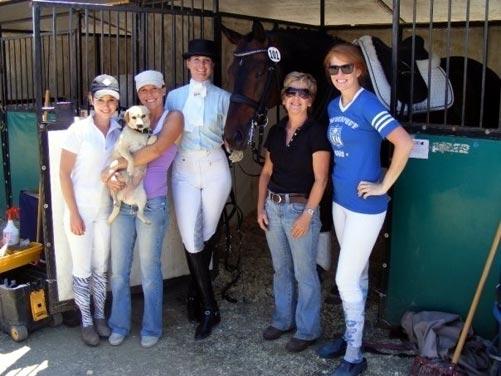It seems that almost every little girl goes through a
‘horse-phase’— a time marked by frequent trips to the local petting
zoo and the collection of every horse related toy on the
market.
However some girls, myself included, never quite outgrow this
phase. Although we have moved on to bigger dreams, such as
replacing the plastic horse figurine that sits on our dresser with
the real thing, our love and appreciation for these majestic
animals remains just as strong as it was in childhood.
My so called ‘horse-craziness’ stemmed from spending time at the
stables while my mom rode her horse— a toddler can only take so
much dust and horse manure before they subconsciously decide to
either love or hate horses. I obviously chose the former of the two
options.
I began horseback riding when I was six years old, and after 15
years and multiple horses, coaches and heartbreaks, I’m just as
passionate about the sport as when I started. Unlike many other
popular sports, horseback riding is unique in the fact that it is
not technically a team sport, and yet it takes an incredible amount
of teamwork. In order to be successful in competition as well as
everyday training, a horse and rider must be compatible. They have
to think alike, compensate for one another’s weaknesses and most
importantly trust each other. A rider must also be diligent about
their horse’s health, because months or even years of training with
one particular horse is not as easily replaced as a broken racket
or a worn out pair of tap shoes. It is all too frequent that a
rider must pull out of competition last minute because their horse
has been injured.
Considering that equestrianism is a fairly common sport in
America, I am always surprised by how little people actually know
about it. Many people think of horseback riding as it is portrayed
in Hollywood, where the John Wayne figure haphazardly gallops off
into the distance. Although heroic cowboys and their trusty steeds
look good on the silver screen, they are not accurate
representations of the equestrian sport.
The Equestrian industry is a billion-dollar business in America
that is comprised of various federations and societies with rules,
regulations and sponsorships that operate similarly to the NFL or
NBA. There are many different equestrian disciplines, like there
are different types of dance (Salsa, Merengue, Ballroom). Each
discipline has a national organization that oversees the general
welfare of the sport by creating and amending legislation, funding
scholarship programs and organizing national events and
competitions. One of the most popular equestrian disciplines here
in Sonoma County, and the one in which I compete, is dressage.
To put it simply, dressage is like ballet on horseback. It
demands grace, strength, and precision, while aiming for the
impossibility of perfection. The horse and rider perform a series
of technical movements, such as small circles, tempo changes and
lateral movements that are initiated by cues from the rider’s legs,
hands and seat.
In competition, riders are required to memorize and perform
uniform ‘tests’ that are regulated by the United States Dressage
Federation. Each test requires the rider to perform a series of
movements and the technical difficulty of the test varies depending
on the competition level— tests range from Training Level
(beginner) all the way to Grand Prix (advanced).
Dressage tests are judged out of a hundred possible points, with
each individual movement being scored on a scale of 1-10, 10 being
perfect. These individual marks are then tallied up to get a final
score. Typical dressage scores range from the high fifties to the
mid seventies, however a rider can achieve a higher or lower score
depending on the quality of their test. Judges award scores based
on the accuracy of the movements, as well as the freedom and
regularity of the horse’s gates and the overall appearance of
harmony between horse and rider.
The roots of modern day dressage can be traced back to Ancient
Greece, where the Greek soldier and historian Xenophon first wrote
about the usefulness of the horse’s natural movement and agility in
war. Xenophon observed that if a horse could be trained to perform
naturally occurring movements (such as moving sideways and leaping
through the air) on command, the horse would become an invaluable
asset in mounted combat, where precision and dexterity were of
utmost importance.
Although dressage is no longer used for military purposes, it
became an Olympic sport in 1912, and is very popular in Western
Europe and is quickly gaining ground in America.
One of the best places to experience dressage in Sonoma County
is at the Dressage in the Wine Country event, located at the Santa
Rosa Fairgrounds. Dressage in the Wine Country (DWC) is a biennial
event that mixes great Sonoma County wines with fun equestrian
entertainment. This year, the 26th DWC takes place on August 29th,
and is sure to be an exciting and fun evening for all.
The afternoon begins with wine tasting and a trade-faire and is
followed by an evening performance full of talented riders, many of
whom are residents of Sonoma County. Local dressage trainer Kristen
Aggers and Marin-based dressage trainer Tanya Vik will both be
riding in the event. In addition to dressage, the evening
performance will include other equestrian disciplines, as well as
the presentation of the American flag and a musical quadrille
ridden by the young members of the Santa Rosa Equestrian European
Pony School.
For non-equine enthusiasts, DWC will feature numerous wineries
for the tasting event, including Murphy-Goode Winery and Windgap
Wines. There will also be a trade-faire with close to fifty
vendors, selling all kinds of unique and interesting items. As
event organizer and local horse-trainer Judy McHerron said, “[DWC]
is just like a big party. It’s a fun night and a great
afternoon.”
For more information about dressage in the Wine Country and to
experience the beauty of dressage firsthand, please visit www.winecountrydressage.org.
39.2
F
Healdsburg
November 16, 2024








